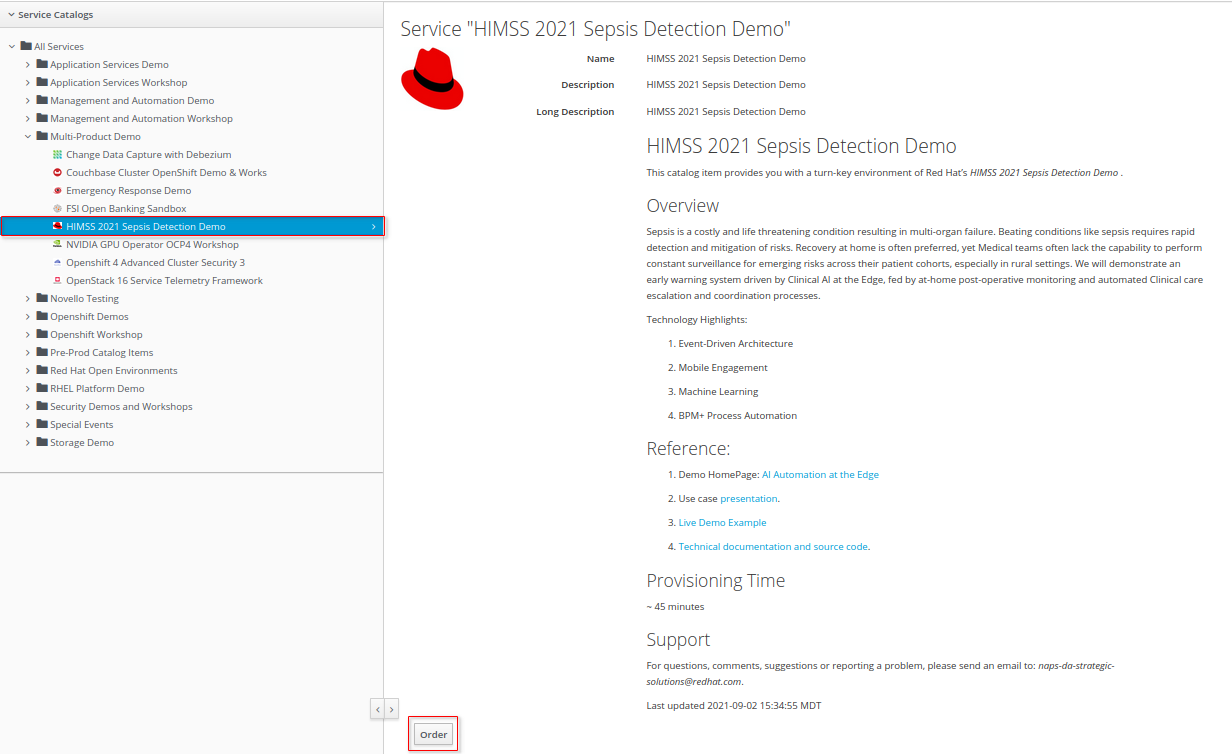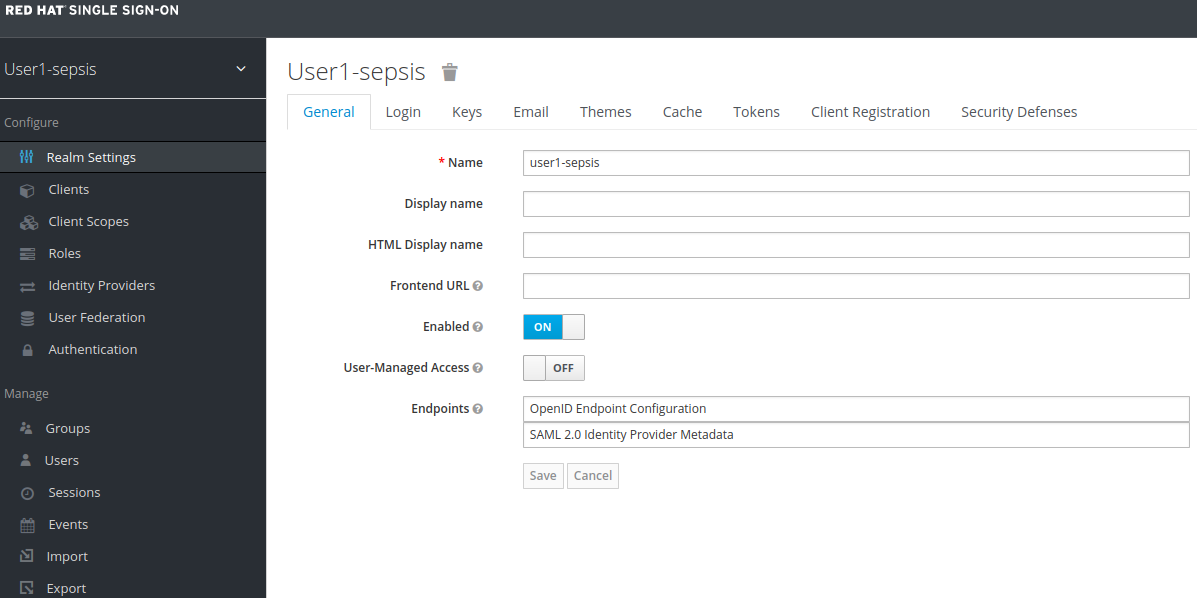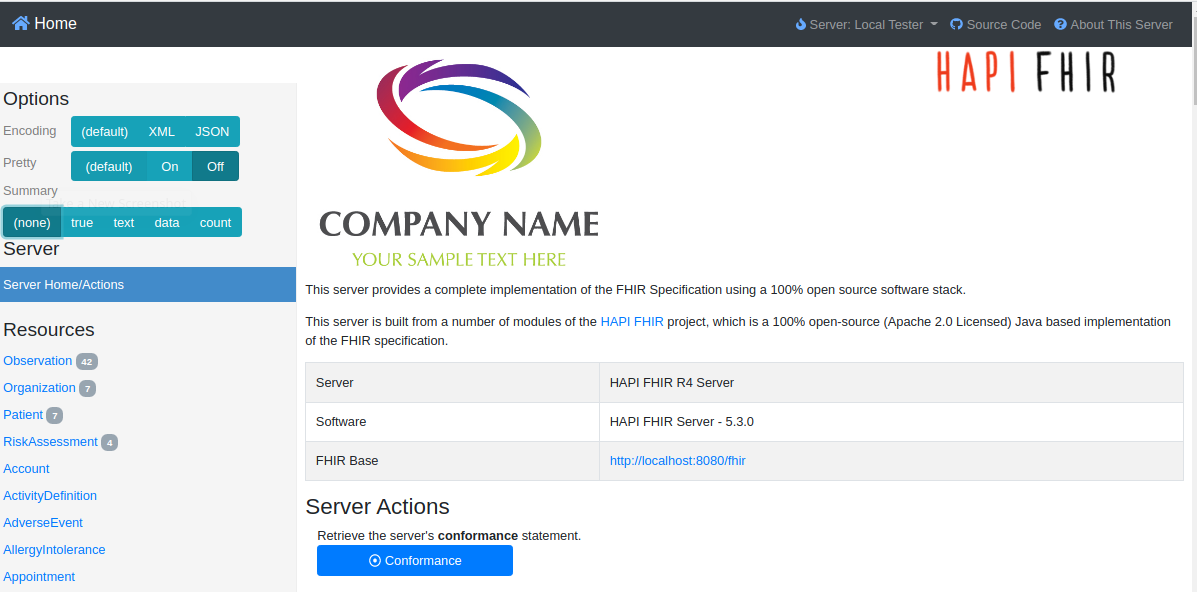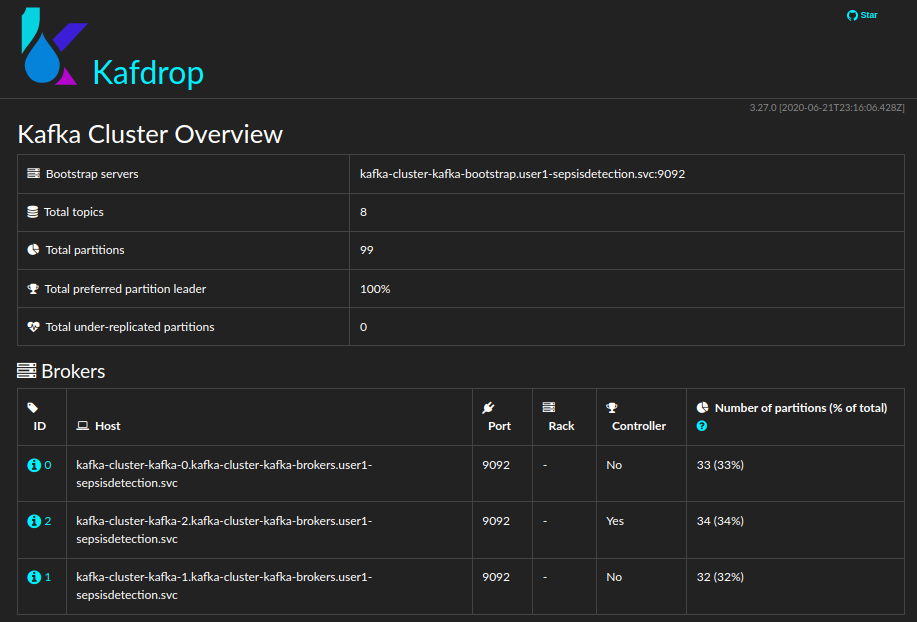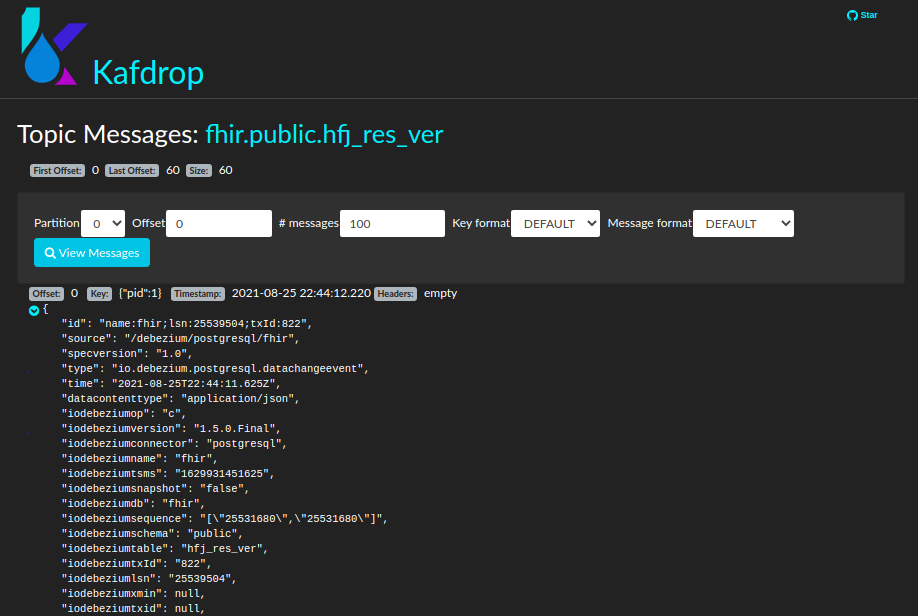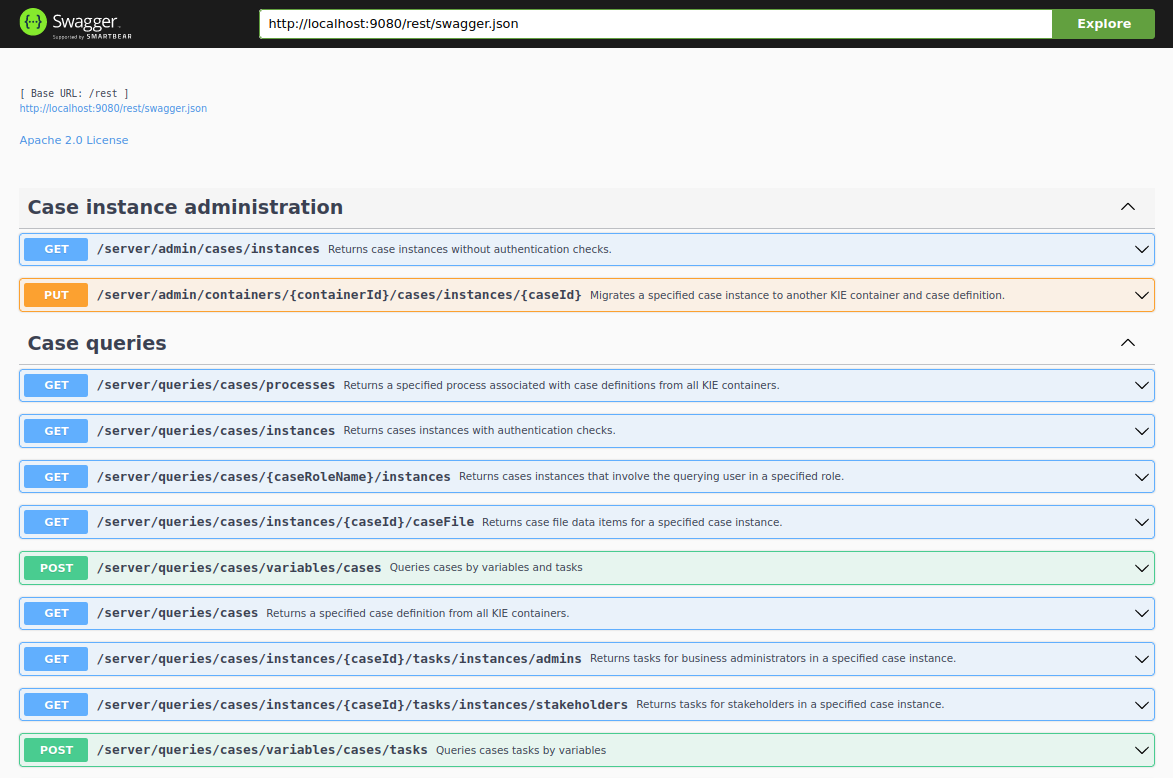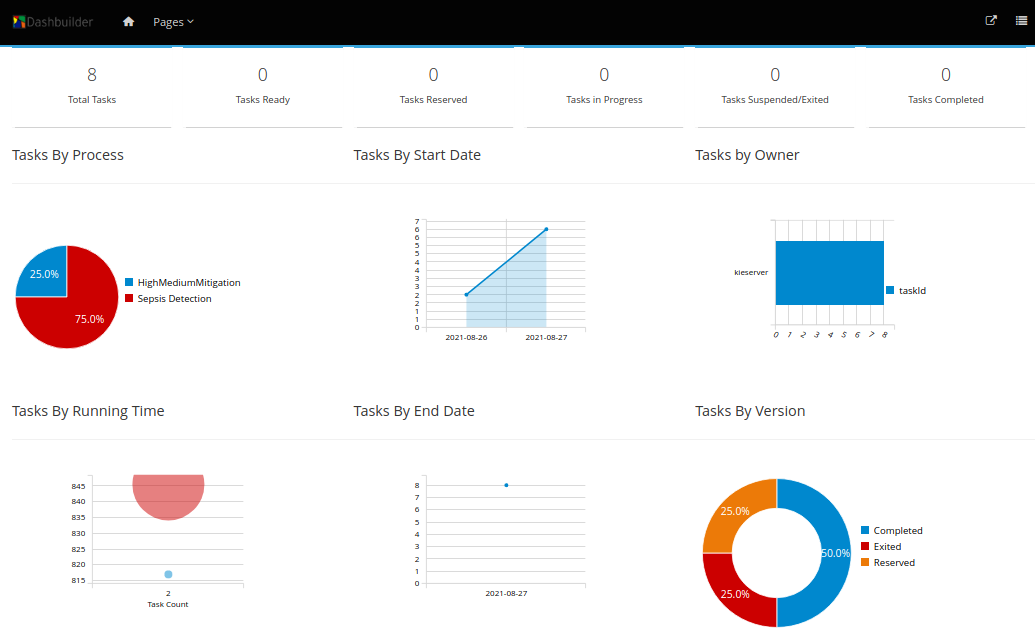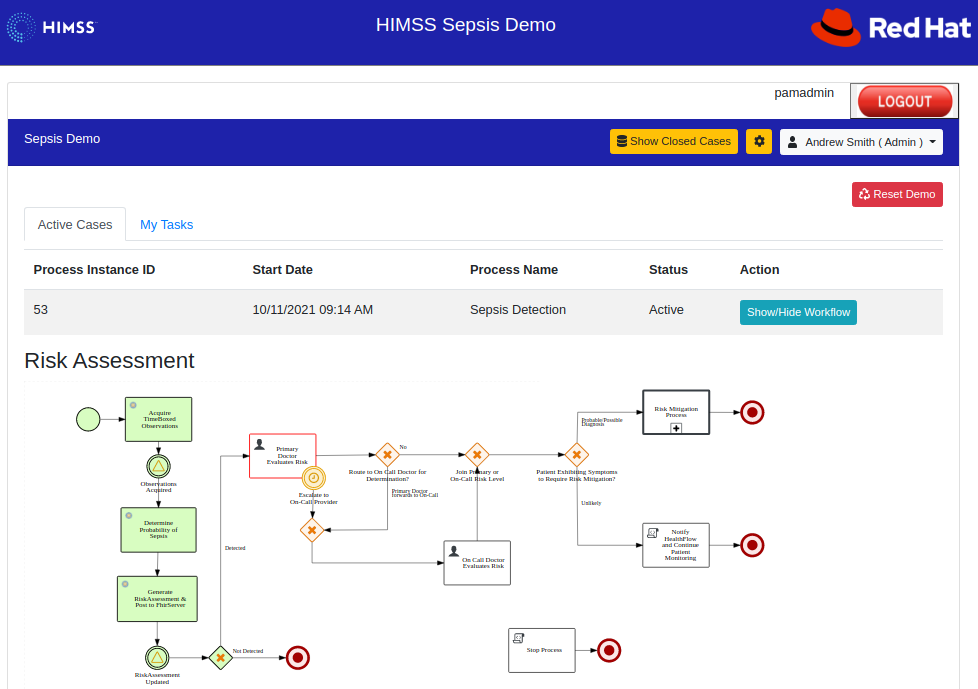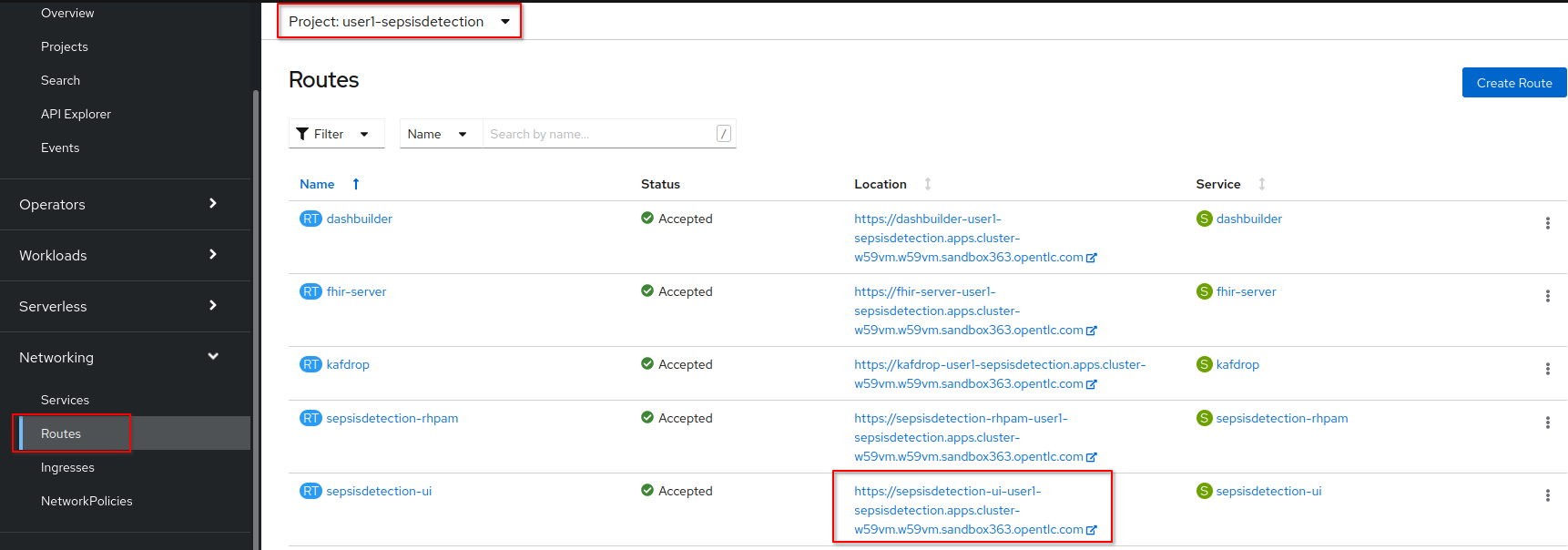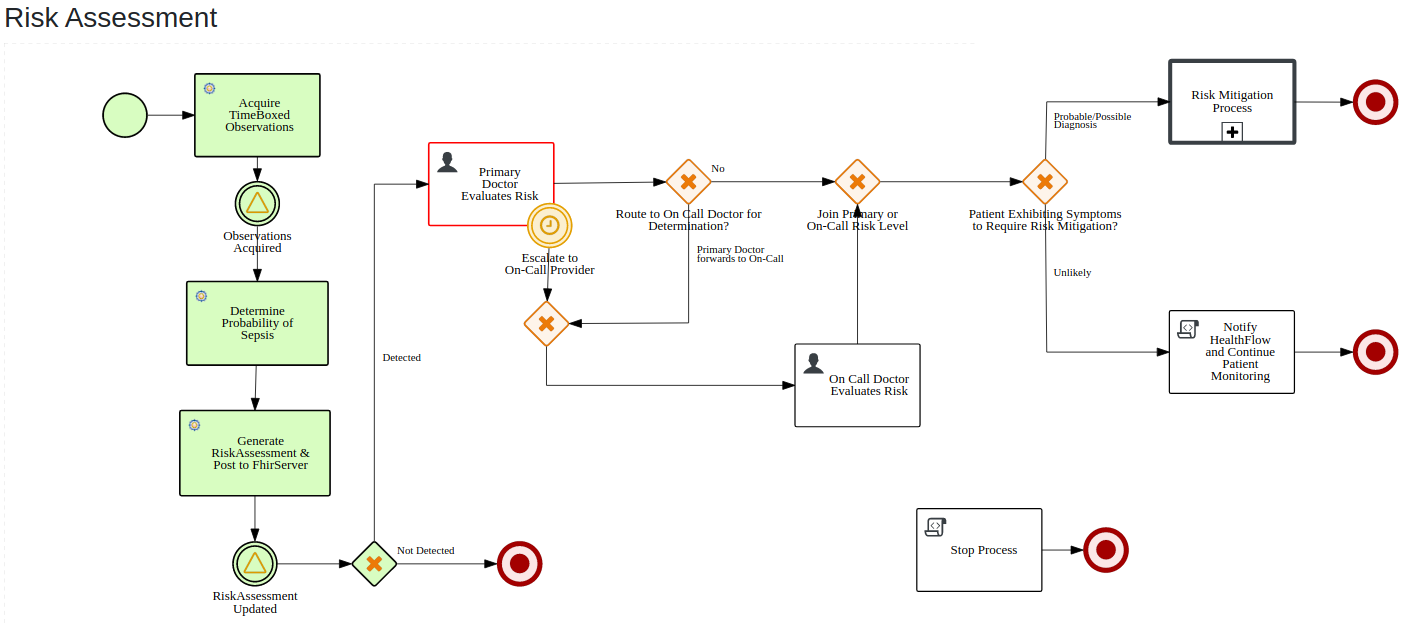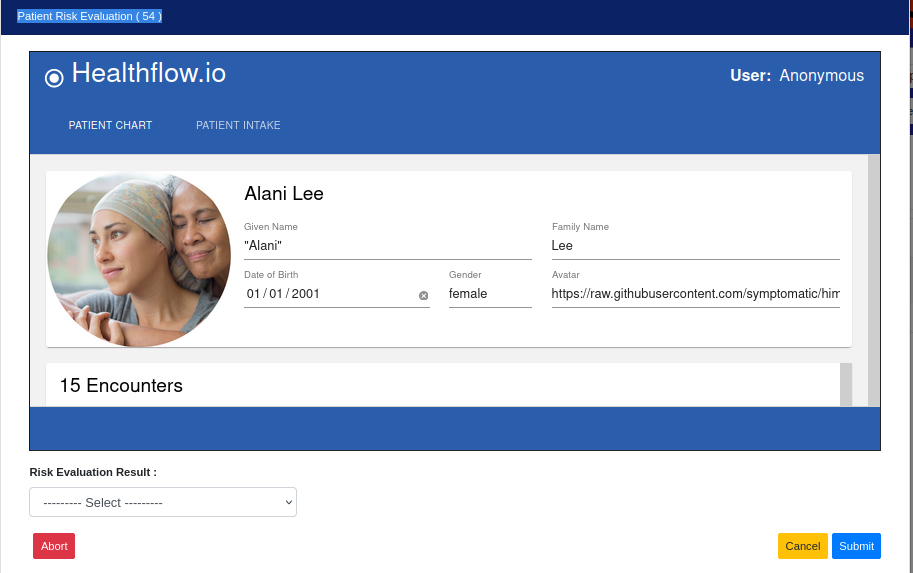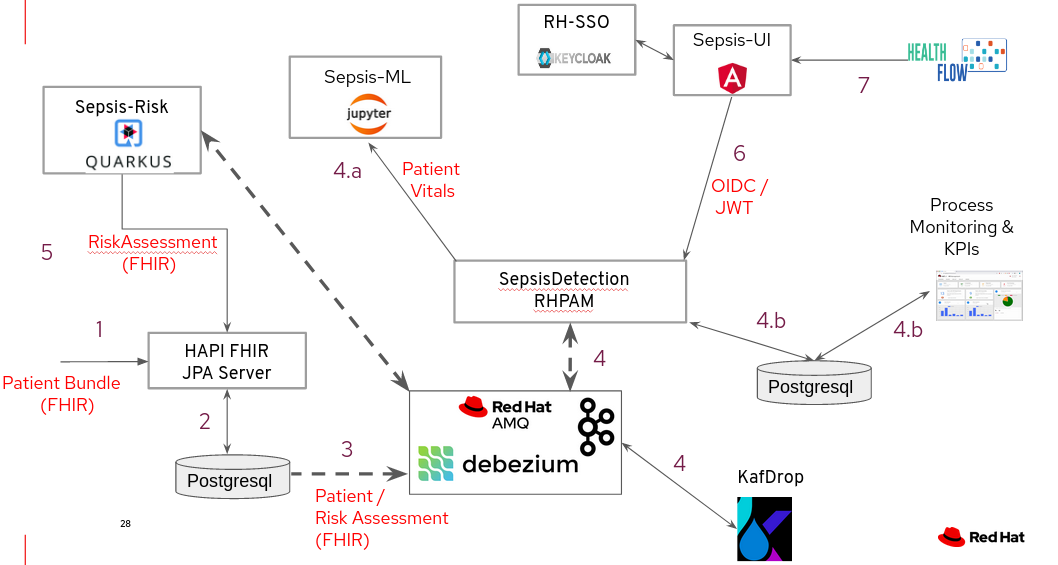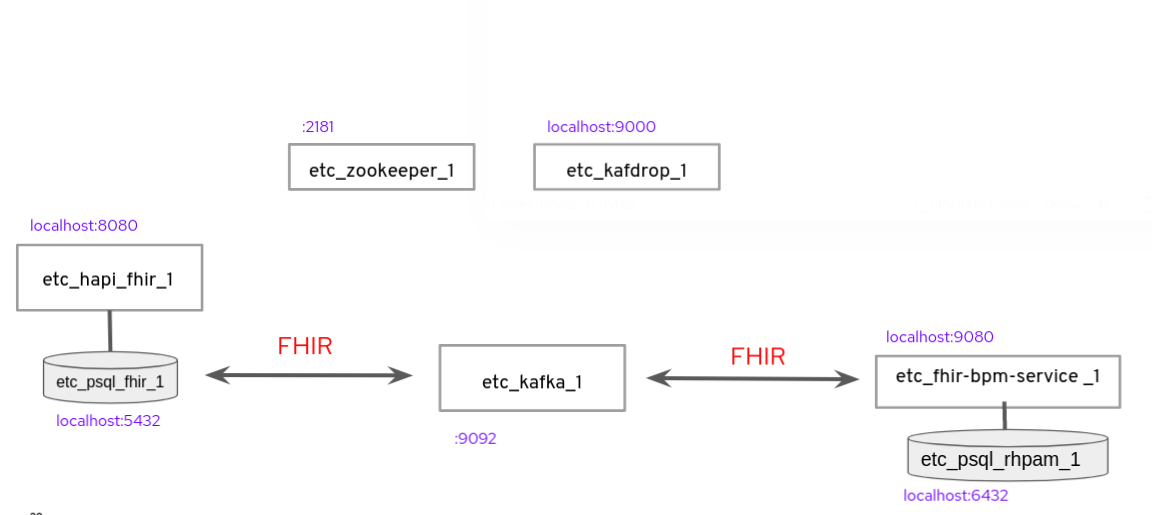Sepsis Detection Demo
1. Overview
The purpose of this project is to provide a reproducible demo of a patient (with a probability of sepsis) encounter at a hospital. This demo uses many Red Hat technologies.
Sepsis is a costly and life threatening condition resulting in multi-organ failure. Beating conditions like sepsis requires rapid detection and mitigation of risks. Recovery at home is often preferred, yet Medical teams often lack the capability to perform constant surveillance for emerging risks across their patient cohorts, especially in rural settings. We will demonstrate an early warning system driven by Clinical AI at the Edge, fed by at-home post-operative monitoring and automated Clinical care escalation and coordination processes.
1.2. Technical Discussion Vectors
-
Operations
-
Ansible for automated and repeatable deployment of Application Services to OpenShift
-
Deployment of Red Hat Application Services products via Operator Lifecycle Manager
-
-
Events in Motion
-
Use of Red Hat AMQ Streams
-
Use of Debezium for Change Data Capture on HAPI FHIR database
-
Use of both Binary and Structured Cloud Events
-
Visibility of events via KafDrop
-
Raw FHIR related Server Sent Events streamed to Angular UI
-
-
Process Automation
-
RH-PAM embedded in SpringBoot as process automation engine
-
BPMN models with process variables of type FHIR R4
-
User Task centric process model with Task lifecycle driven by clients via KIE-Server API
-
Angular based simple Task Inbox web app
-
KIE-Server APIs extended with custom endpoints that allow for (un)marshalling of HAPI FHIR R4 resources
-
jBPM Executor Service for asyncroneous tasks
-
Dashbuilder for process and task related monitoring and KPIs
-
-
Web Security
Please see OIDC Enabled Workflow Apps for details.
-
Use of OIDC Authorization Code Flow protocol between RH-SSO and Angular web app to obtain JWT based access token
-
Access token includes users roles so as to facilitate UserGroupCallback functionality in RH-PAM
-
KIE-Server APIs of RH-PAM secured via RH-SSO as Bearer-Token endpoints
-
-
Polyglot Frameworks
-
Quarkus
-
SpringBoot
-
JBoss EAP
-
Python
-
KNative Serverless functions
-
Angular
-
-
Machine Learning
-
Machine Learning algorithm to determine probability of Sepsis
-
2. Order from RHPDS
The Red Hat Product Demo System (RHPDS) provides a wide variety of cloud-based labs and demos showcasing Red Hat software. One of the offerings from RHPDS is the HIMSS 2021 Sepsis Detection Demo.
NOTE: Expect the ordering process to take about 1.5 hours total.
-
Log into RHPDS
To utilize RHPDS, you will need the following:
-
OPENTLC credentials are available only to Red Hat associates and Red Hat partners.
-
SFDC Opportunity, Campaign ID or Partner Registration
-
-
In the left panel, navigate to: Catalog → All Services → Multi-Product Demo → HIMSS 2021 Sepsis Detection Demo
-
Read through the overview and click Order at the bottom of the page.
-
Fill in the details in the Lab Information tab
NoteAmong the ordering options, there are several OpenShift cluster sizes to choose from. A size of Training is sufficient to support the demo. -
Click: Submit.
-
Expect to receive an intial two emails providing process within the first 20 minutes of ordering.
While waiting, one suggestion might be to skim through the following 3 sections of this doc: Demo Components, Demo Scenario and Architecture ,
-
Expect a third email about another 40 minutes after the second email.
The base OpenShift environment is now provisioned.
This third email will provide details regarding this OpenShift environment that the demo will run on.
Log into the OpenShift Console using the details provided in the email.
-
After the third email arrives, wait about another 30 minutes for the HIMSS demo itself to fully provision on the base OpenShift.
-
If you’ve logged into the new OpenShift environment at the command line, you can monitor demo installation progress by executing the following:
$ oc logs -f -c manager $( oc get pod -n ansible-system | grep "^ansible" | awk '{print $1}' ) -n ansible-system -
Upon successful completion of the HIMSS demo, a log statement should appear similar to the following:
----- Ansible Task Status Event StdOut (cache.redhat.com/v1alpha1, Kind=HIMSS2021, himss2021-sample/ansible-system) ----- PLAY RECAP ********************************************************************* localhost : ok=233 changed=74 unreachable=0 failed=0 skipped=42 rescued=0 ignored=0 ----------
-
-
The following are OpenShift namespaces with functionality that supports the demo:
$ oc get project | grep 'knative\|sepsis' knative-eventing knative-serving knative-serving-ingress sepsisdetection-sso user1-sepsisdetection
3. Demo Components
The purpose of this section is to highlight the major components of the demo.
3.1. Red Hat SSO
Red Hat SSO is used as the OpenID Connect provider of access tokens needed by other demo components for authentication and authorization.
For the purpose of the demo, the RH-SSO consists a single SSO realm configured with an SSO client and multiple users and roles to facilitate the use case.
3.2. Hapi FHIR Server
The demo consists of a HAPI FHIR JPA server .
This server maintains the state of all FHIR resources involved in the sepsis detection use case.
The HAPI FHIR server is backed by a PostgreSQL database.
3.3. AMQ Streams / Debezium / Kafdrop
The architecture of the demo is primarily event driven.
As such, the demo makes use of Red Hat’s AMQ Streams and Debezium technologies.
For monitoring of kafka topcs in AMQ Streams, the demo provides an instance of Kafdrop
Kafdrop allows for instrospection of messages in the kafka topics.
3.4. Sepsisdetection-rhpam
This service consists of the RH-PAM process_engine embedded in SpringBoot.
-
This service consumes messages from Red Hat AMQ Streams
In particular, it consumes change events from the PostgreSQL database of the HAPI FHIR server.
ie: When a new FHIR Patient resource is posted to the HAPI FHIR REST API, a record is added to the HAPI FHIR PostgreSQL database. Subsequently, a change event that captures this database record is sent to an AMQ Streams/Kafka topic.
-
This service also exposes the following RESTful APIs:
3.5. Dashbuilder
For monitoring of business processes and user tasks the demo provides an instance of RH-PAM’s dashbuilder technology.
4. Demo Scenario
The demo scenario involves 3 different users each with different roles.
An Administrator starts a business process. A doctor reviews the state of the business process and administers any tasks assigned to she/he . A provider then administers any tasks assigned to she/he .
4.1. Reset Demo
-
In the Openshift console, navigate to the routes in the user1-sepsisdetection namespace
-
Authenticate in using credentials of: pamAdmin / pam
-
Click the Reset Demo button:
-
After a few seconds, there should be an active business process:
-
Click the Log out button at the top right corner to log out as an Administrator.
4.2. Doctors: Administer Tasks
-
Log back into the Sepsis Detection UI as a doctor.
Use credentials of: eve / pam.
-
Click
Show/Hide Workflow:Notice the timer on the Primary Doctor Evaluates Risk task. For the purpose of the demo, this timer is set to 1 minute. If not administered within 1 minute of creation, the workflow will automatically route to the On Call Doctor Evaluates Risk task.
-
Click the
My Taskstab: -
On any of the tasks, click the Open button and decide on an appropriate course of action.
-
Select one of the options from the Risk Evaluation Result drop-down.
-
Click Submit.
-
-
Click the Log out button at the top right corner to log out as a doctor.
4.3. Providers: Administer Tasks
-
Log back into the Sepsis Detection UI as a provider.
Use credentials of: bob / pam.
-
Similar to what you already did as a simualated doctor, manage the lifecycle of any tasks assigned to a provider.
5. Architecture
5.1. Sepsis Detection Runtime processes:
5.2. Deployment Architecture
-
An external client POSTs a FHIR R4 bundle (with a Patient, Location and multiple Observation resources ) to the RESTful API of the HAPI FHIR JPA server.
-
HAPI FHIR JPA Server persists (using Hiberate) to its PostgreSQL database. FHIR resources are stored as gzip blobs in the following table of the HAPI FHIR database schema: public.hfj_res_ver .
-
Debezium detects the additional records to the public.hfj_res_ver table and puts them in motion by sending the raw GZIP blobs to a kafka topic: fhir.public.hfj_res_ver
-
Messages in the fhir.public.hfj_res_ver topic can now be viewed via monitoring tools such as KafDrop. The sepsisdetection_rhpam application is also a consumer on that topic. With consumption of a Patient resource, the RH-PAM process-engine embedded in the sepsisdetection-RHPAM application is invoked and a sepsis-detection business process is started.
These business process and corresponding human tasks can be monitored via tools such as RH-PAMs dashbuilder component.
-
As part of the sepsis-detection business process, the RESTful API of the HAPI FHIR server is queried for a list of all Observation resources for the Patient in a given time period and a PatientVitals resource is created.
-
As part of the sepsis-detection business process, the PatientVitals resource is used as the payload of an HTTP POST request to the sepsisdetection-ml function. The function responds with an indication of whether sepsis is likely or not.
-
As part of the sepsis-detection business process, a generateRiskAssessmentCommand message is sent (as a _Cloud Event) to RHT AMQ Streams.
-
-
The SepsisDetection-Risk service consumes the generateRiskAssessmentCommand Cloud Event. A FHIR R4 RiskAssessment resource (which includes the data indicating likelyhood of sepsis) is posted to the FHIR Server via its RESTful APIs.
Debezium detects the addition of the Risk Assessment resource in the HAPI FHIR database and forwards this event as message to Red Hat AMQ Streams.
RH-PAM picks up this change event with the Risk Assessment resource and advances the business process to the next task.
-
A user with a set of roles (defined in RH-SSO) authenticates into the SepsisDetection-UI. The sepsisdetection-ui interacts with RH-SSO (as per the Authorization Code Flow protocol of OIDC) to generate an Access Token. The sepsisdetection-ui interacts with the RESTful KIE-Server APIs (and includes the access token in the request) of sepsisdetection-rhpam and renders a user interface that allows for management of the sepsis-detection business process and corresponding human tasks. Depending on the role of the authenticated user, that user is presented with user tasks with which to work through their lifecycle.
-
The sepsisdetection-ui pulls in an IFrame from HealthFlow.
6. Deploy to OpenShift using Ansible
Ansible is included to deploy this application to OpenShift in a repeatable manner.
This section is only relevant if the desire is to provision the demo on your own OpenShift environemnt and not order the demo from RHPDS .
6.1. Pre-reqs:
-
OpenShift Container Platform version 4.7.* or more recent. Resource requirements needed by the app (doesn’t include resource requirements of Openshift to support itself) is as follows:
-
RAM: 6 GB
-
CPU: 8
-
Storage: 10 PVCs of type RWO (no RWX requirement) and each of size 5 GiB
-
-
cluster-admin credentials to this OpenShift cluster are needed
-
Corresponding oc utility installed locally
All versions of this utility are available at either of the following:
-
https://access.redhat.com/downloads/content/290
RHN subscription required
-
https://mirror.openshift.com/pub/openshift-v4/clients/ocp/?C=M;O=D
Accessible without a RHN subscription
-
-
ansible installed locally
ie: dnf install ansible
-
git installed locally
6.2. Procedure:
-
Using the oc utility that corresponds to the version of OpenShift that you will deploy to, log into the cluster:
$ oc login <OCP API Server url> -u <cluster-admin userId> -p <passwd>
-
Clone the source code of this project:
$ git clone https://github.com/redhat-naps-da/himss_2021_sepsis_detection
-
Change to the ansible directory of this project:
$ cd ansible
-
Deploy to OpenShift:
NoteIf you are running the install from a Mac, it will be necessary to manually create the user1-sepsisdetection namespace prior to the step below. $ ansible-playbook playbooks/install.yml
-
Deployment should complete in about 15 minutes.
-
Notice the creation of a new OCP namespace where the application resides: user1-sepsisdetection
-
At the completion of the installation, expect to see messages similar to the following:
PLAY RECAP ******************************************************************************************************************************************************************************************************* localhost : ok=137 changed=77 unreachable=0 failed=0 skipped=14 rescued=0 ignored=0
-
-
Optional: Uninstall from OpenShift:
$ ansible-playbook playbooks/uninstall.yml
7. Local containerized environment
This project includes a docker-compose config file that allows for deployment of the application as containers in your local environment.
This section is only relevant to developers of the demo
-
Start application pod with all linux containers:
$ docker-compose -f etc/docker-compose.yaml up -d
NoteIf underlying linux container system in use in your local environment is podman, then follow this set-up guide. -
The following diagram depicts the containers instantiated as part of this pod:
-
Post Debezium configs to kafka_connect container:
$ curl -X POST \ -H "Accept:application/json" -H "Content-Type:application/json" \ localhost:8083/connectors/ \ -d "@etc/hapi-fhir/debezium-fhir-server-pgsql.json"NoteThis step is not needed when running the solution in OpenShift. It’s only needed when running the solution in a local containerized environmennt (ie: docker-compose) -
Stop application pod with all linux containers:
$ docker-compose -f etc/docker-compose.yaml down
8. Test
This section is only relevant to developers of the demo
8.1. Environment Variables
Set the following environment variables with values similar to the following:
-
If testing locally deployed application (via docker-compose):
RHSSO_URL=http://localhost:4080 REALM_ID=kieRealm retrieve_token_url="$RHSSO_URL/auth/realms/$REALM_ID/protocol/openid-connect/token" SEPSISDETECTION_RHPAM_URL=http://localhost:9080 FHIR_SERVER_URL=http://localhost:8080
-
If testing environment deployed to OpenShift:
SEPSISDETECTION_RHPAM_URL=https://$(oc get route sepsisdetection-rhpam -n user1-sepsisdetection --template='{{ .spec.host }}') RHSSO_URL=https://$(oc get route sso -n sepsisdetection-sso --template='{{ .spec.host }}') REALM_ID=user1-sepsis retrieve_token_url="$RHSSO_URL/auth/realms/$REALM_ID/protocol/openid-connect/token" FHIR_SERVER_URL=https://$(oc get route fhir-server -n user1-sepsisdetection --template='{{ .spec.host }}')
8.2. RH-SSO
8.2.1. Master Realm
You can also login directly to the custom SSO realm used in the demo. Details as follows:
-
userId : admin
-
password : execute the following from the command line:
$ echo -en "\n$( oc get secret credential-rhsso -o json -n sepsisdetection-sso \ | jq .data.ADMIN_PASSWORD \ | sed 's/"//g' \ | base64 -d )\n" -
url:
Using the credentials listed above, log into the master realm of the RH-SSO server at the following URL:
$ echo -en "\n$RHSSO_URL\n"
8.2.2. Sepsis Detection SSO Realm
-
You can also login directly to the custom SSO realm used in the demo. Details as follows:
-
URL
$ echo -en "\n$RHSSO_URL/auth/admin/$REALM_ID/console\n"
-
userId : ssoRealmAdmin
-
password : pam
-
8.3. HAPI FHIR Server
The application includes a HAPI FHIR Server that exposes RESTful endpoints.
-
Test HAPI FHIR Server CORS headers using a preflight request:
$ curl -i -X OPTIONS -H "Origin: http://localhost:7080" \ -H 'Access-Control-Request-Method: POST' \ -H 'Access-Control-Request-Headers: Content-Type, Authorization' \ "http://localhost:8080/fhir" HTTP/1.1 200 Vary: Origin Vary: Access-Control-Request-Method Vary: Access-Control-Request-Headers Access-Control-Allow-Origin: * Access-Control-Allow-Methods: GET,POST,PUT,DELETE,OPTIONS,PATCH,HEAD Access-Control-Allow-Headers: Content-Type, Authorization Access-Control-Expose-Headers: Location, Content-Location -
POST Demo Observation to FHIR server
$ curl -X POST \ -H "Content-Type:application/fhir+json" \ $FHIR_SERVER_URL/fhir \ -d "@sepsisdetection-rhpam/src/test/resources/fhir/DemoBundle.json" -
POST Demo RiskAssessment to FHIR server
$ curl -X POST \ -H "Content-Type:application/fhir+json" \ $FHIR_SERVER_URL/fhir/RiskAssessment \ -d "@sepsisdetection-risk/src/test/resources/fhir/RiskAssessment.json"
8.4. SepsisDetection RHPAM
The sepsisdetection-rhpam deployment is enabled with the kie_server as well as various endpoints that can consume FHIR payloads.
-
Retrieve an OAuth2 token using the
sepsisdetectionSSO client of the pre-configured SSO realm:TKN=$(curl -X POST "$retrieve_token_url" \ -H "Content-Type: application/x-www-form-urlencoded" \ -d "username=pamAdmin" \ -d "password=pam" \ -d "grant_type=password" \ -d "client_id=sepsisdetection" \ | sed 's/.*access_token":"//g' | sed 's/".*//g') echo $TKN -
By setting fullScopeAllowed=true in SSO client, all roles assocated with an authenticated user will be included in the access token.
These roles can be visualized as follows:
$ jq -R 'split(".") | .[1] | @base64d | fromjson' <<< $TKN | jq .realm_access.roles [ "interviewer", "kie-server", "user" ] -
Health Check Report
$ curl -H "Authorization: Bearer $TKN" \ -H 'Accept:application/json' \ $SEPSISDETECTION_RHPAM_URL/rest/server/healthcheck?report=true -
View raw swagger json
$ curl -H "Authorization: Bearer $TKN" $SEPSISDETECTION_RHPAM_URL/rest/swagger.json | jq .
-
View swagger-ui:
Point your browser to the output of the following:
$ echo -en "\n$SEPSISDETECTION_RHPAM_URL/rest/api-docs/?url=$SEPSISDETECTION_RHPAM_URL/rest/swagger.json\n"
-
List KIE Containers
$ curl -H "Authorization: Bearer $TKN" \ -X GET $SEPSISDETECTION_RHPAM_URL/rest/server/containers -
List process definitions in JSON representation:
$ curl -H "Authorization: Bearer $TKN" \ -X GET -H 'Accept:application/json' \ $SEPSISDETECTION_RHPAM_URL/rest/server/containers/sepsisdetection-kjar/processes/ -
List process instances for a deployment in JSON representation:
$ curl -H "Authorization: Bearer $TKN" \ -X GET -H 'Accept:application/json' \ $SEPSISDETECTION_RHPAM_URL/rest/server/queries/containers/sepsisdetection-kjar-1.0.0/process/instances -
Identify active node of process instance:
$ curl -H "Authorization: Bearer $TKN" \ -X GET -H 'Accept:application/json' \ $SEPSISDETECTION_RHPAM_URL/rest/server/containers/sepsisdetection-kjar-1.0.0/processesses/instances/${pInstanceId}/nodes/instances | jq .[][0] -
List user tasks given a list of roles in access token:
$ curl -H "Authorization: Bearer $TKN" \ -X GET -H 'Accept:application/json' \ $SEPSISDETECTION_RHPAM_URL/rest/server/queries/tasks/instances/pot-owners | jq . -
List user tasks as a Business Admin:
$ curl -H "Authorization: Bearer $TKN" \ -X GET -H 'Accept:application/json' \ $SEPSISDETECTION_RHPAM_URL/rest/server/queries/tasks/instances/admins | jq . -
List cases in JSON representation:
$ curl -H "Authorization: Bearer $TKN" \ -X GET -H 'Accept:application/json' \ $SEPSISDETECTION_RHPAM_URL/rest/server/queries/cases/
9. Additional Development Notes
9.1. HAPI FHIR Server Development & Customizations
-
Start HAPI FHIR server in debug mode:
$ JAVA_OPTS="$JAVA_OPTS -agentlib:jdwp=transport=dt_socket,address=*:5005,server=y,suspend=n" $ mvn clean package -DskipTests -Pboot $ java -DJAVA_OPTS=$JAVA_OPTS -jar target/ROOT.war
-
View bytea type in res_text field of public.hfj_res_ver table:
fhir=# \d hfj_res_ver Table "public.hfj_res_ver" Column | Type | Collation | Nullable | Default ----------------+-----------------------------+-----------+----------+--------- pid | bigint | | not null | partition_date | date | | | partition_id | integer | | | res_deleted_at | timestamp without time zone | | | res_version | character varying(7) | | | has_tags | boolean | | not null | res_published | timestamp without time zone | | not null | res_updated | timestamp without time zone | | not null | res_encoding | character varying(5) | | not null | res_text | bytea | | | res_id | bigint | | not null | res_type | character varying(40) | | not null | res_ver | bigint | | not null |
9.2. sepsisdetection-rhpam
-
Build and install kjar project:
$ cd sepsisdetection-kjar $ mvn clean install -DskipTests
-
Build KIE-Server executable from this project:
$ cd sepsisdetection-rhpam $ mvn clean package
-
Build and Start app
$ mvn clean package -DskipTests && \ java -Dorg.kie.server.repo=../etc/sepsisdetection-rhpam/runtime_configs \ -jar target/sepsisdetection-rhpam-0.0.1.jar &> /tmp/sepsisdetection-rhpam.log & -
Optional: Create a kie-container in kie-server (kie-container should already be registered as per contents of etc/rhpam/sepsisdetection-rhpam.xml )
$ export KJAR_VERSION=1.0.0 $ export KIE_SERVER_CONTAINER_NAME=sepsisdetection-rhpam $ sed "s/{KIE_SERVER_CONTAINER_NAME}/$KIE_SERVER_CONTAINER_NAME/g" etc/rhpam/kie_container.json \ | sed "s/{KJAR_VERSION}/$KJAR_VERSION/g" \ > /tmp/kie_container.json && \ curl -u "kieserver:kieserver" -X PUT -H 'Content-type:application/json' localhost:9080/rest/server/containers/$KIE_SERVER_CONTAINER_NAME-$KJAR_VERSION -d '@/tmp/kie_container.json'
10. Additional References
11. Bug list
-
Decide what to do about integrating with Healthflow.io . Maybe create a simulator
HealthFlow was initially supposed to have been deployed on the kubeframe as part of the demo, but they couldn’t get it containerized in time, so it was relegated to being displayed in that iFrame. There’s a container image out there for it, but it’s monolithic and bulky, and we kind of shelved helping them with it for the time being. It’s based on a project called Meteor, and includes an embedded FHIR server with database instance, as well as some other stuff. Pretty heavy duty.
Example URL:
-
Persisting list of Observations as part of process instance variables caused problems when retrieving those pInstance variables and marshalling to json (so as to be rendered in sepsisdetection-ui ).
-
KnativeEventing
Knative Eventing is not currently used. However, if it was used, there seems to be a problem with starting multiple KnativeKafka installs in the default knative-eventing namespace when deploying in a shared cluster.
12. Operator notes
12.2. Monitoring
The HIMSS Demo operator can be monitored by tailing its log file as follows:
$ oc logs -f -c manager $( oc get pod -n ansible-system | grep "^ansible" | awk '{print $1}' ) -n ansible-system
12.3. Development
12.3.1. Base Operator
-
Modify Makefile (as needed)
-
Build image and deploy to quay:
$ make docker-build docker-push
-
Change latest tag in quay:
In order for the updated sepsisdetection-operator image to be picked up in RHPDS, you’ll need to change the latest tag in quay.io.
-
In your browser, navigate to https://quay.io/repository/redhat_naps_da/sepsisdetection-operator?tab=tags
-
Log into quay.io as admin of the
redhat_naps_daorganization. -
Modify the latest tag such that it is linked with the latest image that was previously pushed.
-
12.3.2. Optional: Deploy operator to your own OCP cluster
-
Deploy operator in OpenShift cluster:
$ make deploy cd config/manager && /u01/labs/mw/redhat-naps-da/himss_interoperability_showcase_2021/ansible/bin/kustomize edit set image controller=quay.io/redhat_naps_da/sepsisdetection-operator:0.0.2 /u01/labs/mw/redhat-naps-da/himss_interoperability_showcase_2021/ansible/bin/kustomize build config/default | kubectl apply -f - I0831 13:00:25.259384 30895 request.go:668] Waited for 1.075752563s due to client-side throttling, not priority and fairness, request: GET:https://api.cluster-3983.3983.sandbox362.opentlc.com:6443/apis/security.internal.openshift.io/v1?timeout=32s namespace/ansible-system created customresourcedefinition.apiextensions.k8s.io/himss2021s.cache.redhat.com created serviceaccount/ansible-controller-manager created role.rbac.authorization.k8s.io/ansible-leader-election-role created clusterrole.rbac.authorization.k8s.io/ansible-manager-role created clusterrole.rbac.authorization.k8s.io/ansible-metrics-reader created clusterrole.rbac.authorization.k8s.io/ansible-proxy-role created rolebinding.rbac.authorization.k8s.io/ansible-leader-election-rolebinding created clusterrolebinding.rbac.authorization.k8s.io/ansible-manager-rolebinding created clusterrolebinding.rbac.authorization.k8s.io/ansible-proxy-rolebinding created configmap/ansible-manager-config created service/ansible-controller-manager-metrics-service created deployment.apps/ansible-controller-manager created
-
Install HIMSS2021 resource
$ oc apply -f config/samples/cache_v1alpha1_himss2021.yaml -n ansible-system
-
Acquire needed configs for use in RHPDS:
$ mkdir rhpds $ bin/kustomize build config/default > rhpds/sepsisdetection-operator-all-configs.yml $ cp config/samples/cache_v1alpha1_himss2021.yaml rhpds
12.3.3. OLM
-
list status of existing OLM on RHPDS cluster
$ operator-sdk olm status --olm-namespace openshift-operator-lifecycle-manager
-
uninstall existing OLM on RHPDS cluster
$ operator-sdk olm uninstall --version 0.17.0
-
install latest OLM in olm namespace
$ operator-sdk olm install
12.4. RHPDS Related Activities
-
Demo Onboarding request into RHPDS
-
agnosticd pull request
